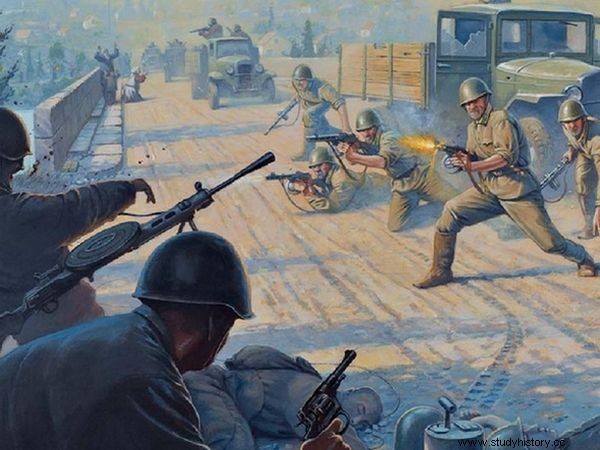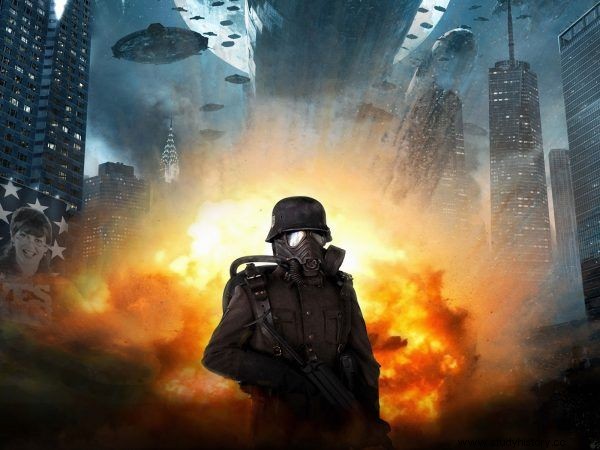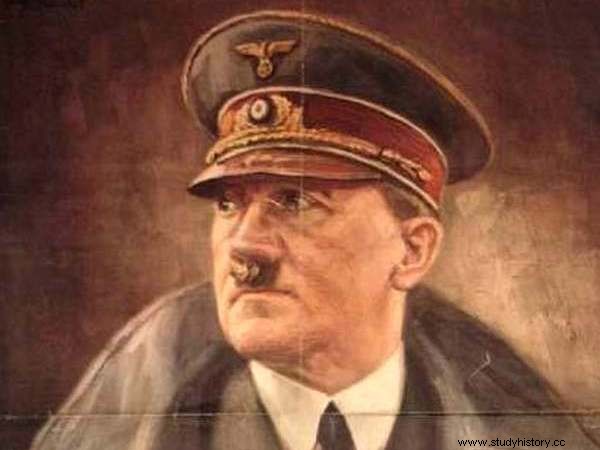Germans disguised as members of the NKVD. Americans, recruiting a special unit from among German communists. The long-planned attacks on Hans Frank and Erwin Rommel. Sometimes even small operations aimed at the enemy's weak point can change the course of the war. Of course, if they succeed ...
As always, all TOP10 items are based on the articles we publish. This time we decided to remind you of the spectacular, though not necessarily successful, operations of special forces during World War II.
Who would have expected that the fate of the war depended on ...
10. Germans in Yankee uniforms…
During the German offensive in the Ardennes, Nazi soldiers tried to gain an advantage over the Americans ... by disguising themselves as them. The operation, initiated by Adolf Hitler himself, was carried out by a special unit of soldiers who spoke fluent English, dressed in American uniforms and equipped with captured weapons and vehicles. The Yankee military slang was learned from prisoners of POW camps. They even had photos taken from dead Americans with them.

Destroyed Pantera tank, which was supposed to pretend to be the American M10 Wolverine tank destroyer (photo:United States Department of Defense).
The aim of the incognito Germans was to capture the bridges over the Meuse. They went into action on the night of December 15/16, 1944, in captured jeeps or on foot, crossing the lines of American troops. They cut telephone wires, changed signposts, one group even managed to steer an entire American infantry regiment on the wrong path.
The Americans decided to catch the wandering "own" speakers in an equally unconventional way. Suspected individuals were asked about "pop culture" knowledge , like who is the current husband of actress Betty Grable… One by one, unprepared saboteurs burst in. They were defeated, and the bridges over the Meuse remained in enemy hands. They got so much that, instead of fighting at the front, thousands of Allied soldiers were looking for them (read more on this topic) .
9. … And disguised as the NKVD
"If we do not take Maykop and Grozny, I will have to end this war," Hitler said at the end of July 1942. The task of intercepting the local oil installations was entrusted to the soldiers of the elite Brandenburg unit. Soldiers were previously trained, incl. handling means of communication and handling explosives. To facilitate their victory and at the same time confuse the opponent, it was also planned that they would wear uniforms "borrowed" from the enemy.

Attack on Maykop. A fragment of the cover of the book Behind Soviet Lines. Hitler's Brandenburgers capture the Maikop Oilfields 1942 ”by David R. Higgins (Osprey series).
This time, the Germans chose the uniforms of the NKVD, wanting to take advantage of the fear that this unit raised universally among the Red Army. In order to turn into typical Chekists, they learned even the jargon of this formation and the ruthless behavior of its members. The curriculum even included "classes" in drinking as much vodka as possible.
The action was a spectacular success. Upon their arrival in Maykop, the false NKVD were warmly welcomed by the real ones. On the eve of the German attack, the commandos operated in three groups. The first blew up the communications center, preventing contact with the front line. The second took the headquarters' telephone exchange and spread false rumors about the evacuation of the city. The third prevented the destruction of the mining infrastructure. The actions of the specialists saved the Germans at least four days of fighting (read more on this topic) .
8. "Cichociemni" from the East
After the German attack on the USSR, the Soviets desperately needed information about the strength of the enemy, the movements of his troops, places of concentration, etc. They used, inter alia, Polish prisoners of war to capture it. A special intelligence group was formed by former officers of the Polish Army who, after June 22, 1941, expressed a desire to establish cooperation with their existing enemies against the German invasion. Soon they were transferred to Poland, where they created one of the most effective intelligence networks of World War II.

On board such a plane, "Cichociemni" from the East reached Poland (photo:MarkusundMeli, license CC BY 3.0).
The Polish sabotage group was dropped just outside the General Government after a month of training. The branch eventually settled in Warsaw. The results achieved by the rapidly organized intelligence network surpassed all expectations. There was so much data that one time it was sent to Moscow almost continuously for 36 hours! The group once even managed to intercept shipments of cigarettes and oranges.
Although, after less than a year of existence, the Germans arranged the cauldron by smashing the net, by then its reports allowed for the reconstruction of the full picture of the German concentration of troops before the summer offensive in 1942. The Soviets made good use of this information. They launched a pre-emptive strike, thus the offensive in the Caucasus was delayed by as much as six weeks. Perhaps it was this delay that was responsible for the final defeat of the Germans (read more about it) .
7. Kamikaze from Yontan
When, in November 1944, American bombers, taking off from the Marianas bases, made the first raid on Tokyo in two years, the idea of establishing the Giretsu Kuteitai, formation emerged in the Japanese General Staff. that is, "heroic paratroopers." This special unit was to attack Yankee bases at night. Soldiers of iron condition were selected for it, who used various types of weapons very well and knew eastern martial arts. They were trained in the destruction of bombers with explosives.

American air defense fire at the Yontan airport in Okinawa (photo:T.Sgt. Chorlest, National Archives and Records Administration collection, public domain).
The Japanese decided to use Giretsu Kuteitai during the fighting for Okinawa that started in March 1945. The Americans captured the local airports on the day of landing. One of them - Yontan - was to recover paratroopers for special tasks. They set off - on board 12 bombers - on May 24, 1945. It was originally a suicide mission . Each kamikaze before death was to destroy at least 2 enemy planes.
However, the ambitious plan was not fully implemented. Due to technical faults and shelling only one machine managed to land . Overnight Giretsu They destroyed only 9 planes and damaged 29. They fired 265 thousand. liters of fuel. Three Americans were killed, eighteen were injured. Meanwhile, all the Japanese - 69 soldiers - were killed. The suicide commando action had little effect on the outcome of the fighting in Okinawa. It could have had an impact on the final end of the struggle in the Pacific (read more about it) .
6. Bombers from the Home Army
Hans Frank was close to the end of the war and died in January 1944. The Home Army soldiers prepared a plan to blow up the train on which the Governor General was going to Lviv. They also organized TNT from the Wieliczka mine, machine guns and grenades to complete the work with a fire ambush.

Governor Hans Frank in 1943 with members of the Ukrainian harvest festival delegation at Wawel. Only a few months later, his life - and the fate of the General Government - hung in the balance (public domain).
The action began on January 29. The sappers put an explosive device on. The warehouse was noticed around 11:15 pm. Two minutes later, a powerful explosion broke the silence of the night. But it came literally a fraction of a second too late. The rails were torn off the sleepers just behind the last axis of the saloon.
The Germans were extremely lucky: none of them was seriously injured. Although the Home Army tried to blame the Soviet partisans, in retaliation for this attack, the Germans shot a hundred Krakow residents (read more on this topic) .
5. Rangers climbing the cliff
Perched on the high cliff of Pointe du Hoc, the German battery of six heavy guns was a deadly threat to the invasion fleet on Day D. It could only be attacked from the sea. The mission was undertaken by the US 2nd Ranger Battalion, which was to land at the foot of a 30-meter rock, climb it and destroy the cannons. Easy, right?

Rangers and captured German defenders of Pointe du Hoc (Public Domain).
On June 6, around 4.00 more than two hundred soldiers were transferred from the transporters to the landing craft. It was extremely difficult to climb to the shore in the dark and with the rushing current. Nevertheless, the Americans were determined. After nailing some people started climbing with their bare hands without any security. The first Rangers reached the top of the cliff 5 minutes after landing.
Despite the trouble with finding the guns - in the place where they were expecting them, there were telephone poles imitating the barrels - managed to destroy them all. In addition, the specialists found and blew up an artillery ammunition warehouse. The mission objective was accomplished and thousands of allies owed their lives to the Rangers (read more about this) .
4. Nazi terrorists in New York
60 years before the attacks on the World Trade Center, a similar operation was planned by the Germans. People deported from the USA, trained in the Abwehr center near Berlin, were recruited for the "Pastorius" action. The saboteurs were to hit the most sensitive points of American metropolises, such as power plants, bridges and metro stations. The hardest blow was to fall on New York. The Germans wanted to induce a fear psychosis in American society and undermine his confidence in the government.

In the movie "Iron Sky", the Nazis attack the United States from space. The reality was less spectacular, but if the operation "Pastorius" had been successful, its psychological effect would have been difficult to overestimate (in the illustration from the cult film).
An eight-man squad landed just after midnight on June 13, 1942, on a beach near Long Island. The saboteurs wore German uniforms, in case of failure to fall under the provisions of war conventions. The successful landing, however, was the end of their successes on American soil ... Already while they were hiding their equipment, a Coast Guard cadet ran into them and informed his superiors about the incident. The Germans managed to escape, and the patrol who arrived there found only German uniforms in the sand, but the Americans were warned. The manhunt has started.
Some terrorists, knowing that they were wanted, simply went to their relatives and friends. Others chose to come out to avoid punishment. Thanks to the information they provided, everyone was arrested in a short time. The saboteurs - although in fact they did not do anything punishable - court murders were committed. Six of them were executed on electric chairs (read more about that) .
3. An Italian liliputian ship
The idea of attacking New York also appeared in Italy, a month after the unsuccessful action of the Germans, i.e. in July 1942. Its originators wanted to hit the morale of the Yankees and force them to allocate more funds to defend their own ports, thereby weakening their strength in the ocean.

This was the wreckage of the Liilliputian CA2 ship, excavated by the French (public domain).
The attack was scheduled for December 1943. A liliputian ship called CA2 and several divers from the elite Gamma group were assigned for the operation. Work has been commissioned to adapt the submarine, affectionately known as the kangaroo, to be transported on board CA2.
Why didn't the attack finally happen? Italians had previously decided to take similar action against naval bases in Sierra Leone and South Africa. The kangaroo then ventured as far as the port in Durban. Admittedly, he successfully neutralized a total of as many as four Allied ships however, he himself was sunk in the high seas during the operation. The loss of an already prepared ship and a ceasefire between Italy and the Allies saved New York from the Italian invasion (read more about it) .
This article has more than one page. Please select another one below to continue reading.Attention! You are not on the first page of the article. If you want to read from the beginning click here.
2. Brits hunting the Fox (Desert)
The British wanted to hasten the end of the war in Africa by sending their best commandos to capture or kill Erwin Rommel - the famous "Desert Fox". The action was codenamed "Flipper" and it was planned to be carried out on the night of November 18-19, 1941. At the same time, it was planned to launch an attack by the British 8th Army, aimed at unblocking the besieged by the Axis of Tobruk. The German troops would run out of a capable commander at the decisive moment ...

If Operation Flipper had been successful, Rommel would not have been alive at the time this photo was taken. Who knows how it would change the fate of the war? (Bundesarchiv, Bild 101I-785-0286-33 / Otto / CC-BY-SA 3.0).
The commandos arrived in Africa aboard two submarines. From the very beginning, extremely difficult weather conditions made it difficult for them to complete the task. The wind and storm meant that only 33 people from a 59-man unit reached the shore on the day of landing! Despite the downpour, the heroic members of the Scottish Commando headed straight for Rommel's quarters, which they had been instructed to find in the village of Beda Littoria. On the way, they found out that this information was incorrect, and the Desert Fox resided at Sidi Rafa. When finally, despite the difficulties, they managed to get to the right place, they fired a series of machine guns ... however, they did not find the German commander.
The retreat took place in the pouring rain pouring from the sky. Only two people managed to get back to their own positions. And Erwin Rommel? He was then in Rome, unaware of anything, celebrating his birthday with his wife ... (read more about it) .
1. Allied Communists who, pretending to be Nazis, were to kill Hitler
At the end of World War II, a special American unit was established, consisting mainly of German anti-Nazis interned in France. 175 people who managed to recruit were entrusted with one task:the physical elimination of the German authorities, led by Adolf Hitler. The new "allies", almost all with communist views, operated as part of Operation Iron Cross, the purpose of which was to prevent the commanders of the Third Reich from fortifying themselves in the so-called alpine fortress. It was feared that if the Nazi dignitaries managed to shelter there, the war could extend by up to 2 years ...

Iron Cross was tasked with capturing or killing Nazi dignitaries headed by Adolf Hitler (public domain).
The members of the unit were dressed in the uniforms of German mountain shooters. They received special training in guerrilla and sabotage activities. They were prepared to eliminate Nazi officials as effectively as possible. In mid-April 1945, however, the main purpose of the mission was changed. The detachment was no longer to kill, but only to catch the German leaders trying to get to Reduta. The Americans wanted to keep them alive so that they could be brought before a war crimes tribunal. So the members of the squad were trained in commando tactics.
The finale of Operation Iron Cross is scheduled for the end of April. The start was delayed for six days due to bad weather, and finally ... the action was canceled. Officially, the management claimed that the reason for the change of decision was the rapid progress of the Allied forces. It is also possible that the intelligence had already discovered then that Hitler was in besieged Berlin. Or that the politicians did not want to have a hundred armed communists in the American zone of occupation. The unit was disbanded and his team was put back in POW camps (read more about this) .
